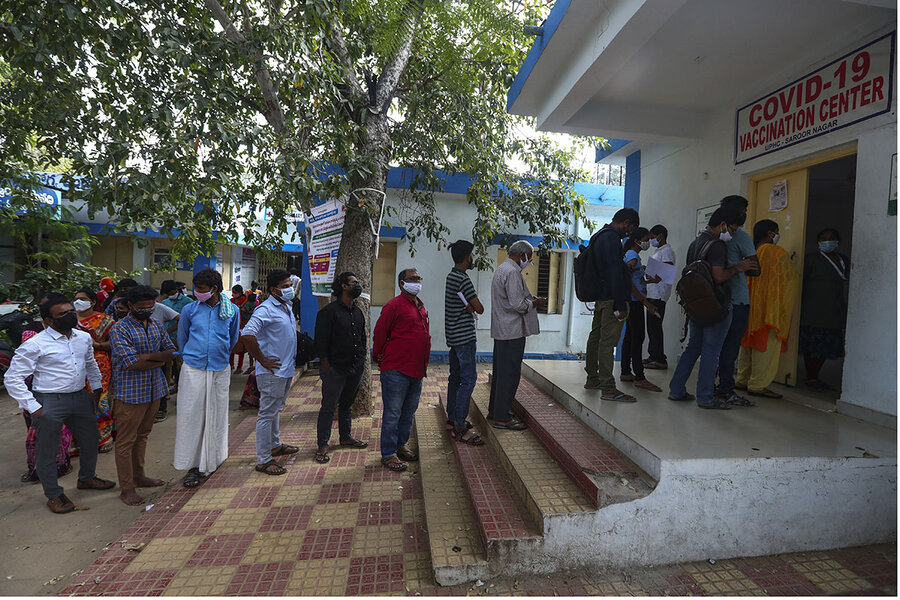Why it’s not just global supply holding women back from vaccines
Loading...
| Johannesburg
When health care worker Grace Jokudu and her colleagues began distributing the COVID-19 vaccine in Wau, a city in the northwest of South Sudan, they quickly noticed a disparity.
When people came to their clinic with symptoms of COVID-19, they were mostly women. But almost everyone lining up to be vaccinated was a man.
Why, they wondered, weren’t there more women in those lines?
Why We Wrote This
When policymakers make assumptions about groups of people, they can devise programs that miss the mark. Actually talking to them about their individual needs can create better outcomes.
Across South Sudan, women account for 70% of all COVID-19 cases, but only 26% of those getting vaccinated, according to October estimates by the international humanitarian organization CARE, for which Ms. Jokudu works. That’s the inverse of many countries in the Western world, including the United States, where women are more likely than men to be vaccinated, by about 10%, according to figures from late June.
Gender gaps have been at the top of vaccination drives in many countries beyond Africa, including Iraq, Timor-Leste, and India, which as recently as July had vaccinated 28 million more men than women, exposing a country’s societal values, norms, and realities on the ground.
“A disaster like a pandemic exposes the inequalities that already exist in our societies,” says Nsovo Mayimele, a pharmacist and women’s health activist in South Africa. “At its core, this is a problem about women being on the receiving end of inequality in our society more generally.”
Although many countries haven’t kept data on vaccination that is broken down by gender, it appears that globally these gaps are also rapidly shrinking – including in South Sudan – thanks to a strategy that many experts say should be at the core of any public health response: Ask people what they need.
“If you get to the level of assuming everyone’s needs are the same, you can’t design programs that actually work for people,” says Helena Ballester Bon, a specialist for the communication for development arm of the United Nations Children’s Fund (UNICEF) working in east and southern Africa.
That seems like simple advice, but in the heat of responding to health crises, it’s often easy to overlook. Ebola responders in both West Africa and Congo, for instance, faced often violent resistance from communities who didn’t understand why strangers in spacesuitlike protective gear were dragging away people to far-away hospitals. Resistance to treatment, and later to vaccines, declined when health responders created Ebola-safe burial rituals that were in line with local customs.
Uptake of the HPV vaccine in Somalia went up markedly when officials started assigning women to do the marketing, making it easier for those considering vaccination to ask questions about sexual and reproductive health without embarrassment.
In the case of the COVID-19 vaccine, more women than men in the U.S. and Canada are getting vaccinated, experts say, in part because women in those places tend to be more proactive about seeking out health care in the first place. But health care workers in many countries across the developing world initially found fewer women than men were showing up to be vaccinated for reasons both practical and philosophical.
On the most basic level, says Ms. Jokudu, “they couldn’t get there.” Vaccination clinics kept business hours, and women were often consumed with household tasks – child care, cleaning, cooking, collecting water, farming – that couldn’t be abandoned. Many had neither time nor money for transportation to far-away clinics.
“Logistically, women are disadvantaged in many ways,” says Emmanuel Ojwang, CARE’s health and nutrition coordinator in South Sudan. “That’s especially true when they have to travel long distances to be vaccinated, because they are very busy with caretaking.”
“We find there are many women who have expressed interest in being vaccinated, but the issue is access,” says Upile Kachila, a senior manager with VillageReach, a health NGO working in Malawi.
For others, hesitancy around vaccination was tied up in rumors that circulated widely around the world about the vaccine affecting fertility. Such rumors have gathered particularly ferocious momentum in regions like Africa, experts say, because so few people overall – about 6% of the population – are fully vaccinated.
But that, too, is a problem with a relatively straightforward solution, experts say.
Give women access to people who can answer their questions.
“Hesitancy is not rejection,” Ms. Bon says. “It’s a continuum. People’s positions can change with better information.”






